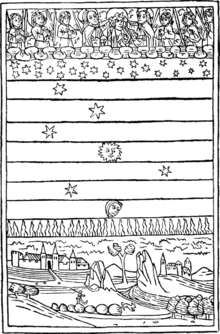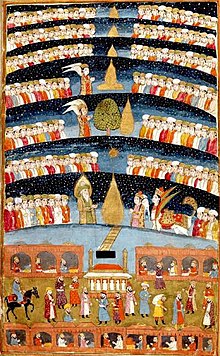Seven heavens

In mythological or
Greek astronomy and cosmology
Each of the seven heavens corresponds to one of the seven
Mesopotamian cosmology
The concept of seven heavens as developed in ancient
The understanding that the heavens can influence things on Earth lent heavenly,
In general, the heavens is not a place for humans in Mesopotamian religion. As Gilgamesh says to his friend Enkidu, in the Epic of Gilgamesh: "Who can go up to the heavens, my friend? Only the gods dwell with Shamash forever". Along with the idea of seven heavens, the idea of three heavens was also common in ancient Mesopotamia.[13]
Abrahamic religions
Judaism
In the
- Vilon (וילון), see (Isa 40:22)
- Raki'a (רקיע), see (Gen 1:17)
- Shehaqim (שחקים), see (Ps 78:23, Midr. Teh. to Ps. xix. 7)
- Zebul (זבול), see (Isa 63:15, 1 Kings 8:13)
- Ma'on (מעון), see (Deut 26:15, Ps 42:9)
- Machon (מכון), see (1 Kings 8:39, Deut 28:12)
- Araboth (ערבות), The seventh Heaven where
The Jewish Merkavah and Hekhalot literature was devoted to discussing the details of these heavens, sometimes in connection with traditions relating to Enoch, such as the Third Book of Enoch.[16]
Apocryphal texts
The
The book's depiction of ten heavens represented an expansion of the ancient seven-heaven model. This expanded
Christianity

The
I know a person in Christ who fourteen years ago was caught up to the third heaven—whether in the body or out of the body I do not know; God knows. And I know that such a person—whether in the body or out of the body I do not know; God knows—was caught up into Paradise and heard things that are not to be told, that no mortal is permitted to repeat.
— (2 Corinthians 12.2–4 NRSV)
The description is usually taken as an oblique reference by the author to himself. The passage appears to reflect first-century beliefs among Jews and Christians that the realm of Paradise existed in a different heaven than the highest one—an impression that may find support in the original Greek wording (closer to "caught away" than "caught up").[18]
In the second century, Irenaeus also knows seven heavens (see his Demonstration of Apostolic Preaching 9; cf. Against Heresies 1.5.2).
Over the course of the
Islam

The
In other sources, the concept is presented in metaphorical terms. Each of the seven heavens is depicted as being composed of a different material, and Islamic prophets are resident in each. The names are taken from
- Raqi'a (رقيعاء): The first heaven is described as being made of water and is the home of Adam and Eve, as well as the angels of each star. According to some narratives, Muhammad encountered the angel Habib here.[27]
- Araqlun (أزفلون): The second heaven is described as being made of white pearls and is the home of Isa (Jesus).
- Qaydum (قيدوم): The Joseph and the Angel of Death (named Azrael) are resident there.[28]
- Maʿuna (ماعونا): The fourth heaven is described as being made of brass (alternatively Enoch) and the "Angel of Tears" reside there.
- Di'a (ريقا): The fifth heaven is described as being made of silver; Aaron holds court over this heaven. Sometimes, the guardian of hellfire is assigned to this place.[27]
- Daqua (دقناء): The sixth heaven is described as being composed of gold (alternatively garnets and rubies); Moses can be found here.[29]
- ʿAriba (عريبا): The seventh heaven, which borrows some concepts from its Jewish counterpart, is depicted as being composed of divine light incomprehensible to the mortal man (alternatively emerald). Abraham is a resident there and Sidrat al-Muntaha, a large enigmatic Lote tree, marks the end of the seventh heaven and the utmost extremity for all of God's creatures and heavenly knowledge.[30]
There are two interpretations of using the number "seven". One viewpoint is that the number "seven" here simply means "many" and is not to be taken literally (the number is often used to imply that in the Arabic language).[31] But many other commentators use the number literally.
One modern interpretation of "heavens" is that all the stars and galaxies (including the Milky Way) are all part of the "first heaven", and "beyond that six still bigger worlds are there," which have yet to be discovered by scientists.[31]
Gnosticism
The Gnostic text On the Origin of the World states that seven heavens were created in Chaos by Yaldabaoth below the higher realms, and each of them are ruled over by an Archon. During the end times, these heavens will collapse on each and the heaven of Yaldabaoth will split in two, causing its stars to fall upon the Earth, therefore causing it to sink into the Abyss.[32]
In the Coptic Apocalypse of Paul, the apostle Paul ascends through the lower Seven Heavens. At the seventh heaven, he meets an old man who opens the gate to the realm beyond the material universe, and Paul then ascends to the eighth, ninth, and tenth heavens.[33]
In Mandaeism, a series of maṭartas, or "toll houses," are located between the World of Light (alma ḏ-nhūra) from Tibil (Earth). The term maṭarta has variously been translated as "watch-station",[34] "toll-station",[35] "way-station", or "purgatory". Maṭartas are guarded by various uthras (celestial beings from the World of Light) and demons. In the Ginza Rabba, seven maṭartas are listed and described in Chapter 3 in Book 5 of the Right Ginza. However, the number of maṭartas is not always seven; Book 6 of the Right Ginza (also known as the "Book of Dinanukht") lists six, and Chapter 4 in Book 1 of the Left Ginza lists eight.[36] Alternatively, the Seven Heavens can also be seen as corresponding to the Seven Planets, who form part of the entourage of Ruha in the World of Darkness.[36]
Hinduism
According to all
See also
- As above, so below – Popular Neo-Hermetic maxim
- Astral religion– Worship of stars and other heavenly bodies as deities
- Empyrean – Highest heaven in ancient cosmologies
- Hierarchy of angels – Belief that angels are ordered according to rank
- Katabasis – Journey into the underworld in literature
- Isra and Mi'raj– Night journey undertaken by Muhammad in Islamic tradition
- Naraka – Hell realm in Jainism
- Ogdoad – Gnostic cosmology of eight heavens
References
- ^ ISBN 978-1317677666.
- ^ Campbell, Robert. "Aristotle's 'On the Heavens'". World History Encyclopedia.
- ISBN 978-3-16-151881-2. Retrieved 3 June 2015.
- ^ "Sumerian Words And Their English Translation". History World. Archived from the original on 10 December 2005. Retrieved 2 June 2015.
{{cite web}}: CS1 maint: unfit URL (link) - ^ ISBN 978-0313294976.
- ^ ISBN 978-3-16-153674-8.
- ^ Stephens, Kathryn (2013). "An/Anu (god): Mesopotamian sky-god, one of the supreme deities; known as An in Sumerian and Anu in Akkadian". Ancient Mesopotamian Gods and Goddesses. University of Pennsylvania Museum.
- ISBN 0-7141-1705-6.
- ^ ISBN 0-19-513009-X.
- ^ Choksi, M. (2014). "Ancient Mesopotamian Beliefs in the Afterlife". World History Encyclopedia.
- ISBN 0-931464-99-4. Retrieved 3 June 2015.
- ISBN 90-04-11927-2.
- ISBN 978-90-04-18903-4. Retrieved 3 June 2015.
- ^ "Angelology". Jewish Encyclopedia. Retrieved 16 June 2015.
- ^ Hagigah 12b
- OCLC 635020.
- ISBN 978-1-62564-991-1.
- ^ E. W. Bullinger. A Critical Lexicon and Concordance to the English and Greek.
2, 14, To this 'Third heaven' and 'Paradise' Paul was caught away, 2 Cor. xii. 2, 4, (not 'up', see under 'catch') in 'visions and revelations of the Lord', 2 Cor. xii. 1. One catching away—with a double revelation of the New heaven and the...
- ISBN 978-1317268864.
- ISBN 81-87385-07-3.
- ^ Coulter-Harris, D. M. (2016). Chasing Immortality in World Religions. USA: McFarland, Incorporated, Publishers. p. 121.
- ^ "The Concept of Seven Skies in Islam". About Islam. Retrieved 2 September 2022.
- ^ Ammi Nur Baits (2 October 2018). "Baitul Izzah, Rumah di Langit Dunia". konsultasisyariah.com (in Indonesian). Yufid. Retrieved 28 November 2023.
Adapun baitul izzah, adalah tempat di langit dunia. Mengenai keberadaannya disebutkan dalam riwayat Ibnu Abbas radhiyallahu 'anhuma, beliau mengatakan, فُصِلَ القُرْآنُ مِنَ الذِّكْرِ [أي: اللّوح المحفوظ]، فَوُضِعَ فِي بَيْتِ العِزَّةِ مِنَ السَّمَاءِ الدُّنْيَا، فَجَعَلَ جِبْرِيلُ عليه السّلام يَنْزِلُ بِهِ عَلَى النَّبِيِّ صلّى الله عليه وسلّم Al-Quran dipisahkan dari ad-Dzikr (Lauhul Mahfudz) lalu diletakkan di Baitul Izzah di langit dunia. Kemudian Jibril menyampaikannya kepada Nabi shallallahu 'alaihi wa sallam. (HR. Hakim dalam al-Mustadrak 2/223, Ibnu Abi Syaibah dalam al-Mushannaf 10/533, dan dishahihkan oleh ad-Dzahabi). Az-Zarqani memberikan komentar untuk riwayat Ibnu Abbas, وهي أحاديث موقوفة على ابن عبّاس غير أن لها حكم المرفوع إلى النبيّ صلّى الله عليه وسلّم لما هو مقرّر من أنّ قول الصّحابيّ فيما لا مجال للرّأي فيه، ولم يعرف بالأخذ عن الإسرائيليّات حكمه حكم المرفوع Hadis ini mauquf sampai Ibnu Abbas, hanya saja dihukumi marfu' sebagaimana sabda Nabi shallallahu 'alaihi wa sallam. Berdasarkan kaidah bahwa perkataan sahabat, untuk masalah di luar logika, dan dia bukan termasuk orang yang suka menerima berita israiliyat, maka status perkataannya sama seperti sabda Nabi shallallahu 'alaihi wa sallam. Beliau melanjutkan, ولا ريب أنّ نزول القرآن إلى بيت العزّة من أنباء الغيب الّتي لا تعرف إلاّ من المعصوم، وابن عبّاس رضي الله عنه لم يعرف بالأخذ عن الإسرائيليّات، فثبت الاحتجاج بها Tidak diragukan bahwa turunnya al-Quran ke baitul izzah termasuk berita ghaib, yang tidak bisa diketahui kecuali melalui Nabi shallallahu 'alaihi wa sallam yang ma'shum. Dan Ibnu Abbas juga bukan orang yang dikenal suka menerima berita israiliyat, sehingga perkataan beliau dalam hal ini boleh dijadikan dalil. (Manahil al-Urfan, 1/45).
- ISBN 9786230801457. Retrieved 28 November 2023.
- ISBN 9789004337121. Retrieved 28 November 2023.
- ISBN 3-515-03177-4.
- ^ ISBN 978-0-7914-7518-8.
- ^ Webster, Richard. "Living in Your Soul's Light: Understanding Your Eternal Self".
- ISBN 0-385-49062-3.
- ^ Abdullah, Yusuf Ali (1946). The Holy Qur-an: Text, Translation and Commentary. Qatar National Printing Press. p. 1139, n. 3814.
- ^ a b |"What Is Meant By 'Seven Heavens'?". Al-Islam.org.
- ^ Marvin Meyer; Willis Barnstone (2009). "On the Origin of the World". The Gnostic Bible. Shambhala. Retrieved 25 October 2021.
- OCLC 124538398.
- ^ Aldihisi, Sabah (2008). The story of creation in the Mandaean holy book in the Ginza Rba (PhD). University College London.
- OCLC 65198443.
- ^ ISBN 9780958034630.
- ISBN 978-0-14-341421-6.
Further reading
- Davidson, Gustav (1994) [1967]. Dictionary of Angels: Including the Fallen Angels. New York: The Free Press. ISBN 0-02-907052-X.
- Ginzberg, Louis (1998). The Legends of the Jews: From the Creation to Jacob. Translated by Henrietta Szold. Johns Hopkins University Press. ISBN 0-8018-5890-9.
External links
![]() Learning materials related to Seven Heavens at Wikiversity
Learning materials related to Seven Heavens at Wikiversity
